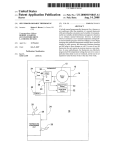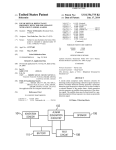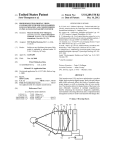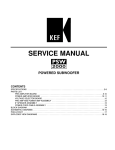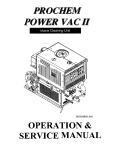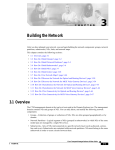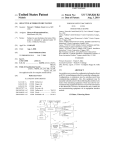Download Self-programmable thermostat
Transcript
US007784704B2 (12) Ulllted States Patent (10) Patent N0.: Harter (54) (45) Date of Patent: SELF-PROGRAMMABLE THERMOSTAT (76) Inventor: Robert J. Harter, 4233 Cliffside Dr., La Crosse’ WI (Us) 54601 (*) Notlce: - Subject to any dlsclalmer, the term of this ~ ~ ~ ~ 5,165,465 A * 11/1992 Kenet ...................... .. 165/11.1 12/1992 5/1999 D’souZa 8/1999 Truong et a1. 6,375,087 B1 4/2002 Day et a1. 6 741 158 B2 5/2004 ’ 2 A 1 N pp . (22) ’ Y - 11/704 414 0.: Filed: Federspiel et a1. ...... .. 236/44C 5,902,183 A 5,943,917 A ’ bb871das U-S-C-154( ) Y Aug. 31, 2010 5,170,935 A * patent is extended or adjusted under 35 (21) US 7,784,704 B2 En ler et a1. g gac?ung et ai' “we” 2003/0040842 A1 2/2003 POLh 2010/0025483 A1* 2/2010 Hoeynck et a1. .......... .. 236/1 C , * Feb. 9, 2007 (65) ' y exammer Primary ExamineriFrantZ F. Jules Assistant ExamineriAlexis K Cox Prior PllblicatiOIl Data Us 2008/0191045 A1 ‘t d b C1 e Aug‘ 14, 2008 (74) Attorney, Agent, or FlI’miWWWbObhaITeI‘; Robert J. Harter (51) Int. Cl. G05D 23/32 (2006.01) G051) 23/00 (2006.01) (57) (52) us. Cl. ................................... .. 236/1 C; 236/44 c (58) Field of Classi?cation Search ............. .. A hybrgl manualgrogr?‘mmabll? lhemtlostat for T 1311mm or 236/46 R, a“ Con “loner 0 er“ e “mp my 0 a manua ‘ ennosta‘ While providing the convenience and versatility of a pro gram mable one. Initially, the hybrid thermo stat appears to function as an ordinary manual thermostat; hoWever, it privately observes and learns a user’s manual temperature setting hab its and eventually programs itself accordingly. If users begin 236/46 C, 1 C, 44 C See application ?le for complete search history. (56) References Cited U.S. PATENT DOCUMENTS 4,335,847 A 4,350,966 A 4,467,178 A 4,469,274 A 4,531,064 A 4,669,654 A 4,751,961 A 5,056,712 A 5,088,645 A 5,115,967 A * 6/1982 Levine changing their preferred temperature settings due to seasonal changes or other reasons, the thermostat continues learning ............ .. ..... .. 236/46 R and Will adapt to those changes as Well. For ease of use, the 9/1982 Nelson * 8/1984 * * 9/1984 Levine 7/1985 Levine Swindle ........... .. ....... .. . thermostat does not require an onscreen menu as a user inter 392/449 face. In some embodiments, the thermostat can effectively program itself for temperature settings that are set to occur at 236/46R . 307/66 6/ 1987 Levine et al. 6/ 1988 Levine et al. 10/1991 ABSTRACT _ particular times daily or just on Weekends, yet the user is not required to enter the time of day or the day of the Week. Enck ............... .. ..... .. 236/20 R * 2/1992 Bell * 5/ 1992 Wedekind ........ .. ..... .. 236/46 R ................ .. ..... .. 236/46 R 5 Claims, 3 Drawing Sheets 38 RECEIVE MANUAL SETPOINTS ANUAL SETPOINTS I MANUALLV ENTERED sETPT TEMP C TED WITH 2A-m ‘nu/or 1-DAV TIMESTAMP A46 52 COMPARE MANUM. SETPOINT TEMP To ADTUAL TEMP AND CONTROL TEMP OOND UNIT ACCORDING“ 20 ACTUAL COMFORT ZONE TEMPERATRURE I REDOGNIlE PATTERN WITH THE MANUALLV ENTERED SETFT TEMPS AND THEIR CORRESPONDING TIMESTAMPS A54 1 BASED ON PATTERN ANDIOR ONE OR MORE OF RULES I-ID. ESTABLISH LEARNED SETPOINT TEMP AND A LEARNED TIME I DURING A FIRST PERIOD STARTING AT THE LEARNED TIMEv COMPARE THE LEARNED sETPDIN T TEMP TO THE ACTUAL TEMP AND CONTROL THE TEMP cOND UNIT ACCORDINGLV I UPON ENCOUNTERING ANOTHER RECOGNIZED PATTERN OR UPON RECIEVING ANOTHER MANLIAL sETPoINT AN DIOR APPLYING ONE OR MORE OF RULES 1-10, INITIATING A SECOND PERIOD IN WHICH THE TEMP COND UNIT l5 CONTRDILED ADOORDINGLY US. Patent Aug. 31, 2010 Sheet 1 013 US 7,784,704 B2 FIG. 1 34k? 38x THERM /12 OSTAT Heat 48 Cool k 16 i : /‘ uProc 36 22 A L14 p f‘ 20 .WDm0.m35w. mpbID.mm.Tm. & A T Sensor 28 24 K 26 j TEMPERATURE CONDITIONING UNIT )0 28 w W 3 2o US. Patent Aug. 31, 2010 US 7,784,704 B2 Sheet 2 0f3 FIG. 2 38 X 48 I TIMER 24-hr and/or 7-day 40 r 44 14 w RECEIVE MANUAL MANUAL SETPOINTS SETPOINTS I MANUALLY ENTERED SETPT TEMP ASSOCIATED WITH 24-hr and/or 7-DAY TIMESTAMP COMPARE MANUAL SETPOINT TEMP /“ 46 20 I f 52 ACTUAL TO ACTUAL TEMP AND COMFORT ZONE CONTROL TEMP COND UNIT ACCORDINGLY TEMPERATRURE RECOGNIZE PATTERN WITH THE MANUALLY ENTERED SETPT TEMPS AND THEIR CORRESPONDING TIMESTAMPS A 54 BASED ON PATTERN AND/OR ONE OR MORE LEARNED OF RULES SETPOINT 1-10,TEMP ESTABLISH AND A ,___ LEARNED TIME I DURING A FIRST PERIOD STARTING AT THE LEARNED TIME, COMPARE THE ACTUAL LEARNEDTEMP SETPOINT AND CONTROL TEMP TO THE TEMP COND UNIT ACCORDINGLY 6O UPON ENCOUNTERING ANOTHER RECOGNIZED PATTERN OR UPON RECIEVING ANOTHER MANUAL SETPOINT AND/OR APPLYING ONE OR MORE OF RULES 1-10, INITIATING A SECOND PERIOD IN WHICH THE TEMP COND UNIT IS CONTROLLED ACCORDINGLY US. Patent FIG. 3 64 Aug. 31, 2010 62“ US 7,784,704 B2 Sheet 3 0f 3 SENSING THE AC TUAL ZONE TEMP 42 RECEIVE FIRST MANUALLY ENTERED SETPT TEMP CONTROL TEMPCOND UNIT IN RESPONSE TO FIRST MANUALLY ENTERED SETPT TEMP A70 RECEIVE SECOND MANUALLY ENTERED SETPT TEMP CONTROL TEMPCOND UNIT IN RESPONSE TO SECOND MANUALLY ENTERED SETPT TEMP A72 RECEIVE THIRD MANUALLY ENTERED SETPT TEMP CONTROL TEMPCOND UNIT IN RESPONSE TO THIRD'MANUALLY ENTERED SETPT TEMP A74 I ASSIGNING TIMESTA MPS TO THE FIRST. SECOND AND THIRD MAN UALLY ENTERED TEMPS IDENTIFY A LEARNED SETPT TEMP BASED ON FIRST, SECOND AND THIRD MANUALLY ENTERED TEMPS CONTROLLING TEMP COND UNIT IN RESPONSE TO THE LEARNED SETPT TEMP A78 A80 I RECEIVE FOURTH MANUALLY ENTERED SETPT TEMP CONTROL TEMPCOND UNIT IN RESPONSE TO FOURTH MANUALLY E NTERED SETPT TEMP 'A 84 SUBSEQUENTLY ONCE AGAIN CONTROLLING TEMP COND UNIT IN RESPONSE TO THE LEARNED SETPT TEMP R86 US 7,784,704 B2 1 2 SELF-PROGRAMMABLE THERMOSTAT Another object of some embodiments is to provide a ther mostat that effectively programs itself as it is being used as a manual thermostat. Another object of some embodiments is to provide a ther mostat that automatically sWitches from a manual mode to a FIELD OF THE INVENTION The subject invention generally pertains to a room or build ing thermostat and more speci?cally to a method of program ming such a thermostat, Wherein the thermostat can in effect programmed mode When it recogniZes an opportunity to do so. program itself for various daily and/ or Weekly temperature setpoints upon learning temperature setting habits of a user and can do such self-programming Without ever knoWing the actual time of day or day of the Week. Another obj ect of some embodiments is to provide a ther mo stat that automatically sWitches from a programmed mode to a manual mode simply by manually entering a neW desired setpoint temperature. Another object of some embodiments is to observe and learn the temperature setting habits of a user and automati BACKGROUND OF RELATED ART cally program a thermostat accordingly. Furnaces, air conditioners and other types of temperature conditioning units typically respond to a thermostat in con Another object of some embodiments is to provide a self programming thermostat that not only learns a user’s tem trolling the air temperature of a room or other area of a perature setting habits, but if those habits or temperature building. Currently, thermostats can be classi?ed as manual or programmable. With manual thermostats, a user manually enters into the thermostat a desired temperature setpoint, and then thermo setting preferences change over time, the thermostat 20 stat controls the temperature conditioning unit to bring the actual room temperature to that setpoint. At various times throughout the day, the user might adjust the setpoint for comfort or to save energy. When operating in a heating mode, for instance, a user might loWer the setpoint temperature at 25 number of setpoint temperatures and times, rather than be night and raise it again in the morning. Although manual limited to a select feW number of preprogrammed settings. Another object of some embodiments is to provide a simple thermostats are easy to understand and use, having to repeat edly adjust the setpoint manually can be a nuisance. Programmable thermostats, on the other hand, can be pro continues learning and Will adapt to the neW habits and set points as Well. Another object of some embodiments is to minimize the number of inputs and actions from Which a user can choose, thereby simplifying the use of a thermostat. Another obj ect of some embodiments is to provide a ther mostat that can effectively self-program virtually an in?nite Way of clearing programmed settings of a thermostat. grammed to automatically adjust the setpoint to predeter mined temperatures at speci?ed times. The speci?ed times One or more of these and/or other objects of the invention are provided by a thermostat and method that learns the manual temperature setting habits of a user and programs can initiate automatic setpoint adjustments that occur daily itself accordingly. 30 such as on Monday-Friday, or the adjustments might occur Weekly on days such as every Saturday or Sunday. For a given day, programmable thermostats can also be programmed to 35 make multiple setpoint adjustments throughout the day, such FIG. 1 is a schematic vieW of a thermostat controlling a temperature conditioning unit. as at 8:00 AM and 11:00 PM on Saturday or at 6:00 AM and 10 PM on Monday through Friday. Such programming, hoW ever, can be confusing as it can involve several steps includ BRIEF DESCRIPTION OF THE DRAWINGS 40 ing: 1) synchronizing the thermostat’s clock With the current time of day; 2) entering into the thermostat the current date or FIG. 2 shoWs an example of algorithm for a thermostat method. FIG. 3 shoWs another example of algorithm for a thermo stat method. day of the Week; and 3) entering various chosen days, times and setpoint temperatures. One or more of these steps may need to be repeated in the event of daylight savings time, electrical poWer interruption, change in user preferences, and 45 various other reasons. FIGS. 1 -3 shoW a thermostat 10 and a method for automati cally programming it. Initially, thermostat 10 might ?rst Consequently, there is a need for a thermostat that offers the simplicity of a manual thermostat While providing the convenience and versatility of a programmed thermostat. DESCRIPTION OF THE PREFERRED EMBODIMENT appear and function as an ordinary manual thermostat. Ther 50 mostat 10, for instance, includes a manual input 12 (e.g., dial, keyboard, pointer, slider, potentiometer, pushbutton, etc.) SUMMARY OF THE INVENTION that enables a user to manually enter a manual setpoint 14 that An object of the invention is to provide an essentially self-programmable thermostat for people that do not enjoy programming conventional programmable thermostats. 55 An object of some embodiments of the invention is to provide a programmable thermostat that does not rely on having to knoW the time of day, thus a user does not have to enter that. 60 Another object of some embodiments is to provide a pro grammable thermostat With both daily and Weekly occurring settings, yet the thermostat does not rely on having to knoW the day of the Week, thus a user does not have to enter that. Another object of some embodiments is to provide a pro grammable thermostat that does not rely on onscreen menus for programming. 65 de?nes a manually entered setpoint temperature 16. The manually entered setpoint temperature 16 is the user’ s desired target temperature for a comfort Zone 18. Upon comparing the manually entered setpoint temperature 16 to the comfort Zone’s actual temperature 20 (provided by a temperature sensor 22), thermostat 10 provides an output signal 24 that controls a temperature conditioning unit 26 (e.g., furnace, heater, air conditioner, heat pump, etc.) to heat or cool air 28 in comfort Zone 18, thereby urging the comfort Zone’s actual temperature 20 toWard the manually entered setpoint tem perature 16. A digital display 30 can be used for displaying the current setpoint temperature, and another display 32 can shoW the comfort Zone’s actual temperature. Displays 30 and 32 could be combined into a single display unit, Wherein the combined US 7,784,704 B2 3 4 display unit could show the current setpoint temperature and to provide thermostat 10 with other functionality, micropro the Zone’s actual temperature simultaneously or in an alter nating manner. Thermostat 10 might also include a selector more of the following rules: cessor 36 can be ?rmware programmed to execute one or switch 34 for manually switching between a cooling mode for Rule- liUpon receiving a manually entered setpoint tem cooling Zone 18 and a heating mode for heating Zone 18. perature, microprocessor assigns an Qi andY) timestamp 48 Items such as display 30, selector switch 34, manual input 12, to the manually entered setpoint temperature, wherein the timestamp indicates when the setpoint temperature was entered relative to other timestamps. The manually entered setpoint temperature and its timestamp 48 are stored in and output 24 are well known to those of ordinary skill in the art. One or more of such items, for example, can be found in a model CT8775C manual thermostat provided by Honey well Inc. of Golden Valley, Minn. memory for later reference. Rule-2iMicroprocessor 36 looks for patterns of manual setpoints, wherein each manual setpoint has a manually entered setpoint temperature and a timestamp 48. Although thermostat 10 can operate as a regular manual thermostat by controlling unit 26 as a function of a differential between the actual Zone temperature and the most recently A daily pattern, for example, can be de?ned as three con entered manual setpoint temperature, thermostat 10 includes a microprocessor 36 (e.g., computer, CPU, ?rmware pro grammed chip, etc.) that enables thermostat 10 to observe the secutive days in which a series of three similar manually entered setpoint temperatures (e.g., within a predetermined deviation of perhaps 20 F. or 5° F. of each other) have similar daily timestamps 48 (e. g., eachY-value being within a prede termined deviation of perhaps 90 minutes of each other). temperature setting habits of the user (e.g., person that manu ally enters setpoint temperatures into the thermostat). After several manual settings, microprocessor 36 may learn the user’s preferred setpoint temperatures and timestamps them 20 daily setpoint temperature could be, for example, an average of the three similar manually entered setpoints temperatures with the aide of a timer 38. With one or more learned setpoint temperatures and timestamps 48, microprocessor 36 can begin anticipating the user’ s desires and automatically adjust the thermo stat’s setpoint temperatures accordingly. Thus, or the most recent of the three. The learned daily time could 25 thermostat 10 can begin operating as a programmed thermo stat, rather than just a manual one. Since a user’ s desired temperature setpoints and time pref erences might change for various reasons, any manually entered setpoint temperature 16 overrides the currently active setpoint temperature regardless of whether the current set point temperature was manually entered or was automatically at a learned time to return thermostat 10 back to its pro 35 grammed mode. Thus, thermostat 10 is somewhat of a hybrid manual/pro grammable thermostat in that it can shift auto manually entered setpoints temperatures spaced 7 days apart 40 peratures, timer 38 can actually comprise one or more timers and/ or counters. In some embodiments, for example, timer 38 45 38 is a continuously operating weekly or l68-hour timer that resets itself every seven days. The increments can be in days, learned daily setpoint temperature becomes activated at its learned daily time, or c) a learned weekly setpoint tempera 50 timer. Timer 38, however, is not necessarily synchroniZed Y values), whereby thermostat 10 controls unit 26 based on the learned weekly setpoint temperature and continues to do 55 a learned daily setpoint temperature becomes activated at its learned daily time (but see Rule-5), or c) another learned weekly setpoint temperature becomes activated at its learned number such as (X and Y) wherein X cycles from 1 to 7 as a 60 weekly time. Rule-54A weekly pattern overrides or supersedes a daily pattern if their assigned timestamps 48 are within a predeter mined period of each other such as, for example, within three hours of each other based on theY-values of their timestamps. day) as a daily timer. In this case, a timestamp 48 might be (3 and 700) to indicate 700 minutes elapsed during day-3. Whether day-3 represents Monday, Tuesday or some other day is immaterial, and whether the 700-minute represents 2:00 AM, 7:30 PM or some other time of day is also imma terial. As one way to provide a programmable thermostat that can operate independently of an actual time of day clock and so until interrupted by one of the following: a) the user enters a manually entered setpoint temperature (adjusts the temp), b) cycle of a daily timer, timestamp 48 might a be a two-part weekly timer, andY cycles from 0 to 1,439 (1,440 minutes per ture becomes activated at its learned weekly time. Rule-4iAutomatically activate a learned weekly setpoint temperature at its learned weekly time (at its assigned X and with the actual time of day or day of the week. Such synchro niZation preferably is not required; otherwise the user might have to manually enter or set the correct time and day of the week. In the case where timer 36 comprises a weekly timer in the form of a 7-increment counter triggered by each 24-hour whereby thermostat 10 controls unit 26 based on the learned daily setpoint temperature and continues to do so until inter rupted by one of the following: a) the user enters a manually entered setpoint temperature (adjusts the temp), b) another hours, minutes, seconds, or any preferred unit. The weekly timer could also be a seven-increment counter that indexes one increment every 24 hours in response to a daily or 24-hour or the most recent of the three. The learned time could be, for example, 20 minutes before the three similar timestamps. Rule-3iAutomatically activate a learned daily setpoint temperature at its learned daily time (at its assigned Y-value), includes a continuously running daily or 24-hour timer that resets itself every 24 hours. The time increments can be in minutes, seconds, or any preferred unit. In some cases, timer A weekly pattern, for example, can be de?ned as three manual setpoints spaced 7 days apart (e. g., same X-value after one complete 7-day cycle) in which three similar manu ally entered setpoint temperatures (e.g., within 20 F. or 5° F. of each other) have similar timestamps 48 (e.g., each Y-value being within 90 minutes of each other). Such a weekly pattern can then be assigned a learned weekly setpoint temperature and a learned weekly time. The learned weekly setpoint tem perature could be, for example, an average of the three similar matically between manual and programmed operation. To assign timestamps 48 to manually entered setpoint tem be, for example, 20 minutes before the three similar times tamps. For future automatic settings, the 20 minutes might allow microprocessor 36 to activate the learned daily setpoint temperature before the user would normally want to adjust the setpoint. 30 activated as a learned setpoint temperature. Once overridden, another learned setpoint temperature might later be activated Such a daily pattern can then be assigned a learned daily setpoint temperature and a learned daily time. The learned 65 Rule-6iIf a user enters a manually entered setpoint tem perature, thermostat 10 controls unit 26 in response to the manually entered setpoint temperature and continues to do so US 7,784,704 B2 6 5 until interrupted by one of the following: a) the user enters 9) If a user has to repeatedly correct a learned Weekly another manually entered setpoint temperature (adjusts the temp), b) a learned daily setpoint temperature becomes acti setpoint (e.g., correct it 2 Weeks in a roW), that learned set point is deleted and no longer used. vated at its learned daily time, or c) a learned Weekly setpoint temperature becomes activated at its learned Weekly time. seconds or so, deletes the entire collection of learned data. 10) SWitching betWeen heating and cooling, for at least 5 To execute one or more of the aforementioned rules, micro Rule-7iIf a user enters tWo manually entered setpoint processor 36 could operate under the control of various algo rithms, such as, for example, an algorithm 40 of FIG. 2, an algorithm 42 of FIG. 3, a combination of algorithms 40 and temperatures Within a predetermined short period of each other, e.g., Within 90 minutes of each other, the ?rst of the tWo manual entries is disregarded as being erroneous and is not to be considered as part of any learned pattern. 42, or another algorithm altogether. Referring to the example of FIG. 2, a block 44 represents receiving a plurality of manual setpoints 14 that are manually Rule-8iIf a learned daily setpoint temperature is activated at a learned time and is soon interrupted by the user entering entered at various points in time over a period, each of the a manually entered setpoint temperature Within a predeter mined short period (e.g., Within 3 hours), and this occurs a predetermined number of days in a roW (e.g., 3 days in a roW as indicated by the X-value of timer 38), then the daily pattern manual setpoints 14 provides a manually entered setpoint temperature 16 that in block 46 becomes associated With a timestamp 48 via timer 38. Timer 38 can run independently or associated With the learned daily setpoint temperature is irrespective of the actual time of day and irrespective of the erased from the memory. actual day of the Week. In blocks 50 and 52, thermostat 10 Rule-9iIf a learned Weekly setpoint temperature is acti vated at a learned time and is soon interrupted by the user controls unit 26 as a function of a differential betWeen the 20 entered setpoint. In block 54, microprocessor 36 recogniZes entering a manually entered setpoint temperature Within a patterns With the manually entered setpoints. Based on the patterns, in block 56 microprocessor 10 establishes learned predetermined short period (e.g., Within 3 hours), and this occurs a predetermined number of Weeks in a roW (e.g., 2 Weeks in a roW as indicated by an additional counter that counts the cycles of the X-value of timer 38), then the Weekly pattern associated With the learned Weekly setpoint tempera setpoint temperatures and corresponding learned times. In 25 the manually entered setpoint temperatures (block 50), auto temperature conditioning unit in response to the learned set point temperature. This might continue until interrupted by 30 microprocessor 36 receiving temperature feedback signal 20 35 be installed at some other location to sense the room tempera ture such as the temperature of air 28 entering unit 26. Blocks each spaced a Week apart). Based on those patterns, establish 40 differential betWeen the comfort Zone temperature and the 45 5) If a learned Weekly setpoint and a learned daily setpoint 50 subsequently receiving a fourth manually entered setpoint ably a Saturday or Sunday. 6) Whenever the user manually adjusts the temperature, the 55 cated by block 86. or learned setting. 7) If a user repeatedly tWeaks or adjusts the temperature 60 temperature is used for learning purposes, as the other set tings are assumed to be trial-and-error mistakes by the user. 8) If a user has to repeatedly correct a learned daily setpoint (e. g., correct it 3 days in a roW), that learned setpoint is deleted and no longer used. Using 3 days as the cutoff avoids deleting a good daily pattern due to 2 days of corrections over a Weekend. temperature. Block 84 represents controlling unit 26 in response to the fourth manually entered setpoint temperature. Some time after that, thermostat 10 returns to controlling unit 26 in response to the learned setpoint temperature, as indi remains active until it is interrupted by a subsequent manual Within a short period, only the last manually entered setpoint response to a differential betWeen the learned setpoint tem perature and the actual Zone temperature. Block 82 represents daily setpoint is ignored on that day because the day is prob manually entered setpoint temperature alWays overrides the currently active setting. The manually entered setpoint various manually entered setpoint temperatures. Block 76 represents assigning timestamps 48 to the various manually entered setpoint temperatures. A block 78 represents micro processor 36 identifying a learned setpoint temperature based on the ?rst, second and third manually entered setpoint tem peratures. In block 80, thermostat 10 controls unit 26 in setpoint. are set to occur near the same time on given day, the learned 64, 66 and 68 represent microprocessor 36 sequentially receiving ?rst, second and third manually entered setpoint temperatures. Blocks 70, 72 and 74 represent thermostat 10 controlling unit 26 at sequential periods in response to a setpoint. 4) Activate learned Weekly setpoints at learned times, and keep them active until the activated setpoint is overridden by the next learned setpoint or interrupted by a manually entered from temperature sensor 22. Sensor 22 could be incorporated Within thermostat 10, as shoWn in FIG. 1, or sensor 22 could peratures and times 3 days in a roW), and identify Weekly patterns (3 similar manually entered temperatures and times learned setpoint temperatures and learned times. 3) Activate learned daily setpoints at learned times, and keep them active until the activated setpoint is overridden by the next learned setpoint or interrupted by a manually entered block 60, Wherein microprocessor 36 encounters another rec ogniZed pattern or upon receiving another manual setpoint, at Which point unit 26 is controlled in response thereto. Referring to the example of FIG. 3, a block 62 represents Rules 1-10 might be summarized more concisely but per haps less accurately as folloWs: 1) Assign timestamps 48 to every manually entered set point temperature. 2) Identify daily patterns (similar manually entered tem block 58, some time after controlling unit 26 in response to matically sWitching at the learned time to controlling the ture is erased from the memory. Rule-10iActuating sWitch 34 betWeen cool and heat or actuating some other manual input can be used for erasing the entire collection of learned data. actual Zone temperature 20 and a currently active manually 65 Although the invention is described With respect to a pre ferred embodiment, modi?cations thereto Will be apparent to those of ordinary skill in the art. The scope of the invention, therefore, is to be determined by reference to the folloWing claims: The invention claimed is: 1. A thermostat method for a temperature conditioning unit, Wherein the temperature conditioning unit helps control a temperature of a comfort Zone, the method comprising: US 7,784,704 B2 8 7 receiving a ?rst manually entered setpoint temperature, 4. The thermostat method of claim 3, further comprising: Which is assigned a ?rst timestamp; after controlling the temperature conditioning unit in controlling the temperature conditioning unit in response to the ?rst manually entered setpoint temperature; receiving a second manually entered setpoint temperature, response to the fourth manually entered setpoint tem perature, returning to controlling the temperature con ditioning unit in response to the learned setpoint tem Which is assigned a second timestamp; perature. controlling the temperature conditioning unit in response to the second manually entered setpoint temperature; receiving a third manually entered setpoint temperature, Which is assigned a third timestamp; 5. A thermostat method for a temperature conditioning unit, Wherein the temperature conditioning unit helps control 10 a temperature of a comfort Zone, the method comprising: controlling the temperature conditioning unit in response to the third manually entered setpoint temperature; receiving a ?rst manually entered setpoint temperature, identifying a learned setpoint temperature based on the ?rst controlling the temperature conditioning unit in response to the ?rst manually entered setpoint temperature; receiving a second manually entered setpoint temperature, Which is assigned a ?rst timestamp; manually entered setpoint temperature, the second manually entered setpoint temperature, and third manu ally entered setpoint temperature; and controlling the temperature conditioning unit in response Which is assigned a second timestamp; to the learned setpoint temperature; and Wherein the ?rst timestamp, the second timestamp, and the third timestamp are based on a 24-hour timer and all lie Within a predetermined range of each other based on the 20 Which is assigned a third timestamp; 24-hour timer. 2. The thermostat method of claim 1, Wherein ?rst manu controlling the temperature conditioning unit in response to the third manually entered setpoint temperature; ally entered setpoint temperature, the second manually entered setpoint temperature, and third manually entered set point temperature all lie Within 5° F. of each other. 3. The thermostat method of claim 1, further comprising: after controlling the temperature conditioning unit in response to the learned setpoint temperature, receiving a fourth manually entered setpoint temperature; and after receiving the fourth manually entered setpoint tem perature, controlling the temperature conditioning unit in response to the fourth manually entered setpoint tem perature. controlling the temperature conditioning unit in response to the second manually entered setpoint temperature; receiving a third manually entered setpoint temperature, identifying a learned setpoint temperature based on the ?rst 25 manually entered setpoint temperature, the second manually entered setpoint temperature, and third manu ally entered setpoint temperature; and controlling the temperature conditioning unit in response 30 to the learned setpoint temperature; and Wherein the ?rst timestamp, the second timestamp, and the third timestamp are based on a l68-hour timer








